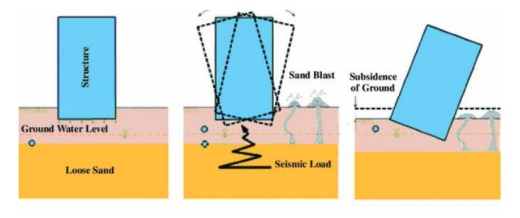Oregon DEQ Seismic Report Late 2024
Oregon DEQ Seismic Report Late 2024
Our Oregon Department of Environmental Quality will report the condition of Critical Energy Infrastructure Hub fuel storage tank infrastructure in November 2024 under the terms of SB 1567. This report will reference the submittals collected from CEI Hub Operators.
Oregon DEQ will soon set rules that CEI Hub Operators must answer when they submit their SB 1567 reports by July 2024. Multnomah County Democrats call for these rules to be taken from existing hazardous materials regulations currently enforced by the US EPA to manage corroding infrastructure.
Proceedings Before the Oregon Department of Environmental Quality Fuel Tank Seismic “ Stability? ” 2023
Rules for DEQ Reports
Rules will never change facts of nature, so any Rules Advisory Committee work products must be consistent with best available science.
Geoscience
Seismic events have been observed as long as science has been observing them. They do not stop. There is certainty that more will occur. Seismic building codes can reduce the risk of structural collapse if imposed during construction, including structural foundations, to attain a definable structural stability when exposed to inevitable seismic energy. It is unreasonable to expect seismic stability of any structure without seismic design.
Portland CEI Hub Risk
There is no public record or pictorial evidence of structural longevity with above ground storage tanks. There is ample evidence of structural corrosion and collapse from recent video footage of unregulated sacrificial infrastructure.
CEI Hub Google Earth Flyover | Cascadia Living
Underground storage tanks are known to fail due to corrosion of metals. Regulations have been adopted to reduce the risk of environmental contamination caused by corroded structure.
Frequent Questions About Underground Storage Tanks | US EPA
There is no reason to believe that above ground storage tanks erode less than those underground, or that hazards from above ground tanks are of less risk to the environment. The CEI Hub seismic deficiencies threaten 100 miles of downstream river estuaries and wetlands in two states. There is no petroleum distribution infrastructure in the country that is more vulnerable to seismic collapse than the CEI Hub. Current EPA storage tank safety criteria can be applied to above ground storage structures unless safe seismic foundations are known to be in place.
Suggested DEQ Rules for the RAC stability reports implementing Oregon SB 1567:
- An above ground storage tank must be retired from service if used to store petroleum or hazardous materials in excess of 110 gallons, AND
- If fabricated with obsolescent rivetted plate construction, or
- If located in flood plain or on dredge fill soils with no known seismic compliance foundation, or
- If the tank is unanchored, or
- Tank roof structure has collapsed or is condemned for site safety, or
- Tank structure is devoid of leak detection, or
- Tank has no fire suppression, or
- Tank has no secondary containment*, or
- Tank has no flexible tank fill coupling and flexible evacuation coupling.
- Unless a seismic safety margin is on record that assures a structural design safety factor of 4 beyond 100% operating structural load, the operating capacity of the storage tank shall be limited to 25% of design capacity.
- Containment berms must be capable of retaining 125% of the operating capacity of the tank.
*Secondary containment per the US EPA:
- “Placing one tank inside another tank or one pipe inside another pipe (making them double-walled systems)
- Lining the excavation zone around the [tank] system with a liner that cannot be penetrated by the hazardous substance”
SB 1567 Burden of proof
NOTE: These rules for reports are not law or changes to law, but rather the basis for an analysis of public safety risks widely recognized by the civil engineering community as critical, while Hub operators have left known structural deficiencies uncorrected for 10 years, with no public record of ANY structural safety compliances.
NOTE: There is no prospect of immediate and safe corrective action apparent from the recent Multnomah County $50B lawsuit filed with Oregon Circuit Court in Multnomah County, naming Exxon Mobil, Shell, Chevron, BP, ConocoPhillips, Motiva, Occidental Petroleum, Anadarko Petroleum, Space Age Fuel, Valero Energy, Total Specialties USA, Marathon Petroleum, Peabody Energy, Koch Industries, American Petroleum Institute, Western States Petroleum Association, and McKinsey & Company.
NOTE: As tragic as the heat dome events were, putative “accountability and fairness” are not the same as seismic design preparedness attained prior to the pending Cascadia Subduction Zone historically catastrophic event that best science describes as even more tragic than weather. This disaster can occur during protracted litigation. Delayed action for infrastructure reinvestment is neither precautionary nor safe.
https://www.multco.us/multnomah-county/news/multnomah-county-sues-oil-companies-over2021-heat-dome-disaster
NOTE: We seem to be still waiting for USGS, DOGMI, OSU and any registered Oregon geologist to cite the terrible damage multiplier caused by Portland basin terrain that increases destruction from amplified liquefaction of unstable soils. No different than Vancouver BC, reported in 2020.
https://ui.adsabs.harvard.edu/abs/2020EGUGA..2221355S/abstract
Liquefaction and tanks

Example of effects on 600 storage tanks adjacent to the North Willamette
https://www.geotech.hr/en/soil-liquefaction/

Issue Questions
Will there be ANY reserve funding for rapid infrastructure reinvestment for CEI Hub operators facing a $50B legal liability in the Oregon Circuit Court ?
Since it appears to us that none of the $50B will be available for CEI Hub risk mitigation, what is the beneficial purpose of Multnomah County obtaining such funds.?
Sam Kahl, Infrastructure Study Group Lead
Martin Mendelson, MD, Infrastructure Study Group
Ethan Scarl, PhD, Media Study Group Lead
Tracy Farwell, Energy Infrastructure Journalist
Endorsed by Multnomah County Platform Committee
